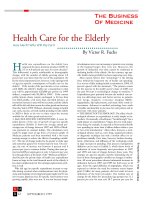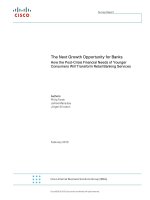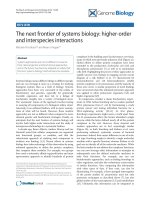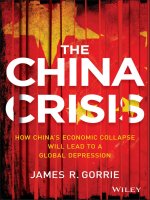kaji & ogawa (eds.) - who will provide the next financial model; asia's financial muscle and europe's financial maturity (2013)
Bạn đang xem bản rút gọn của tài liệu. Xem và tải ngay bản đầy đủ của tài liệu tại đây (4.44 MB, 296 trang )
Sahoko Kaji
Eiji Ogawa Editors
Who Will Provide
the Next Financial
Model?
Asia’s Financial Muscle and Europe’s
Financial Maturity
Who Will Provide the Next Financial Model?
Sahoko Kaji
●
Eiji Ogawa
Editors
Who Will Provide the Next
Financial Model?
Asia’s Financial Muscle and Europe’s
Financial Maturity
Editors
Sahoko Kaji
Professor
Keio University
2-15-45 Mita, Minato-ku
Tokyo 108-8345, Japan
Eiji Ogawa
Professor
Hitotsubashi University
2-1 Naka, Kunitachi
Tokyo 186-8601, Japan
ISBN 978-4-431-54281-0
ISBN 978-4-431-54282-7 (eBook)
DOI 10.1007/978-4-431-54282-7
Springer Tokyo Heidelberg New York Dordrecht London
Library of Congress Control Number: 2013932550
© Springer Japan 2013
This work is subject to copyright. All rights are reserved by the Publisher, whether the whole or part of
the material is concerned, specifically the rights of translation, reprinting, reuse of illustrations, recitation,
broadcasting, reproduction on microfilms or in any other physical way, and transmission or information
storage and retrieval, electronic adaptation, computer software, or by similar or dissimilar methodology
now known or hereafter developed. Exempted from this legal reservation are brief excerpts in connection
with reviews or scholarly analysis or material supplied specifically for the purpose of being entered and
executed on a computer system, for exclusive use by the purchaser of the work. Duplication of this
publication or parts thereof is permitted only under the provisions of the Copyright Law of the Publisher’s
location, in its current version, and permission for use must always be obtained from Springer. Permissions
for use may be obtained through RightsLink at the Copyright Clearance Center. Violations are liable to
prosecution under the respective Copyright Law.
The use of general descriptive names, registered names, trademarks, service marks, etc. in this publication
does not imply, even in the absence of a specific statement, that such names are exempt from the relevant
protective laws and regulations and therefore free for general use.
While the advice and information in this book are believed to be true and accurate at the date of
publication, neither the authors nor the editors nor the publisher can accept any legal responsibility for
any errors or omissions that may be made. The publisher makes no warranty, express or implied, with
respect to the material contained herein.
Printed on acid-free paper
Springer is part of Springer Science+Business Media (www.springer.com)
Preface
In the past 4 years, our faith in the present financial model has been shaken in terms
of monetary, regulatory and exchange rate policies, as well as the business model of
the financial sector itself. Past and present policies of the world’s most respected
central banks have come under fire. Regulations that defined the system underwent
major reviews. Fancy financial instruments that provided new ways of financial
intermediation and wealth creation were exposed as the culprits behind the near
financial meltdown. And after ten successful years, Europe’s single currency came
under threat. In short, the established financial model was not only unable to prevent
the crises but also arguably a cause.
Inasmuch as there are business cycles, economies recover at some point. However,
economic recovery is one thing, finding a financial model conducive to stability is
quite another. To avoid the repetition of the near collapse of the global economy, we
cannot just aim for a simple recovery. Important questions are staring us in the face;
the broadest is whether the West is ceding its position as leader to the East. Without
agreeing on an answer to this broad question, we can ask who will provide the new
financial model conducive to stability and prosperity. Clearly, we cannot go back to
business as usual. But if that is the case, what do we do now? As the crisis deepens,
the temptation is to change as little as possible, out of fear of the unknown. But no
change now means further trouble down the road. The world is in search of a new
financial model.
Japan knows this search all too well. Back in the 1980s, Japan’s economy was
rapidly approaching the status of “number one”. In the middle of this fateful decade,
a bubble emerged in the Japanese financial and real estate markets and while it lasted
gave the false impression of success and prosperity. Japan’s method of financial
intermediation and financial regulation changed in the eyes of the West from obscure
to commendable. The visibility and status of Japan’s banks, insurance companies
and securities houses soared in the global arena. Purportedly, Japan’s unique method
of financial intermediation was superior in enabling long-term planning by borrowers, supporting low unemployment and economic stability. Many thought that Japan’s
financial model represented an alternative to the Anglo-American model and that it
should be adopted by fellow Asians and even eventually by those in the West.
v
vi
Preface
Then we learnt that this was only an illusion. Japan’s bubble burst and was
followed by two “lost decades”. Japan’s financial model not only did support longterm business ties, but it also preserved cosy, unproductive relationships among
regulatory authorities, financial institutions and firms.
After Japan’s financial model lost its shine, life actually became simpler for the
Japanese. They just had to say “mea culpa”, abandon the Japanese way of finance
and adopt Western finance methods. This became a national goal. Many were the
meetings held, reports written, and papers and books published to press this point.
Under the banner of “from saving to investment”, households were encouraged to
move money out of savings accounts and into mutual funds, and schools were
encouraged to teach young children the principles of investing. Japanese financial
authorities, as well as Japanese private financiers, believed that all that was needed
to avoid another bubble was to adopt more Western methods of finance and policymaking. The goal was clear, even if it was not being achieved soon enough.
However, this also proved to be an illusion. Unfortunately (or fortunately), before
Japan completely adopted Western methods of finance, the subprime crisis and
Lehman shock hit. This was followed by the euro crisis. The situation in Japan
today is not dissimilar to the early 1990s where some said “give us back the (Berlin)
wall”. Life was simpler when systems were classified as either Capitalist or
Communist. In the same way, life was simpler for the Japanese when financial systems were divided into Western and Japanese. Now things are more complicated.
One of the two contrasting models was discredited, but blind faith in the remaining
one does not assure stability and prosperity. There is no longer a model, at least not
an obvious one, to work towards. Every country is looking for a new financial
model. How do Asia and Europe compare in the quest for this model?
We need to seriously rethink how we conduct monetary policy and regulate the
financial sector. How should central banks conduct monetary policy in crises? How
should financial regulation be coordinated, and what kind of incentive should they
create to avoid a crisis, to recover from a crisis and to sustain growth? Another
important aspect of finance is exchange rate systems. What does the crisis in the
euro area tell us about exchange rate regimes in Asia and in general? These questions are even more pertinent with the increased, if not exploding, fiscal deficits and
debts in Japan and the West.
This conference volume records the cumulative result of three EUSI conferences
on these topics. The first, held in December of 2009, was entitled “Financial Crises,
learning from Europe, learning from Asia”. The second and third, held in December
2010 and 2011, respectively, both shared the title of this volume; the agendas of
these two conferences essentially carry over into the content of this book.
First on the agenda is financial regulation. Iain Begg and Atsushi Mimura discuss
the efforts to improve financial regulation in the EU and in Asia, respectively. Their
analyses show that even as the EU takes steps in the context of integration, the “premium forum” for cooperation is moving to the G20 and the FSB (Financial Stability
Board), which include emerging economies and international authorities. Europe is
facing the triple task of getting its own house in order, leading the way in financial
integration, while maintaining consistency with and seeking funds from the diverse
Preface
vii
world outside the EU. In Asia, where the level of diversity is much greater than in
the EU, no concrete model of unique financial regulation is emerging. This is not
necessarily a weakness because it shows that diversity is the norm in Asia.
The second topic is monetary policy. Francesco Drudi, Alain Durree and
Francesco Paolo Mongelli explain why central banks must have a clear policy objective and appropriate risk management. They also describe the European Central
Bank’s policies during the different phases of the crisis since August 2007. This is
followed by an assessment of unconventional monetary policy by Shigenori
Shiratsuka. The Bank of Japan’s policies in the late 1990s “demonstrate more similarities than differences” with those taken by major central banks in the current
crisis. The asset sides of the central banks’ balance sheets reflect their choice
between emphasis on macroeconomic stability and financial system stability. The
last paper on this topic is by Akira Ariyoshi, who states that Europe learnt very little
from the Asian financial crisis and lists some lessons for Asia from Europe. A common underlying theme of all three papers is that monetary authorities in both Asia
and Europe face the same economic logic (the impossible trinity, moral hazard,
information asymmetry, importance of market expectations, the blurred line between
monetary and fiscal policy during crises). Every policy choice has a trade-off and all
policy authorities must choose the combination (including eclectic mid-points) of
costs and benefits that is best under the circumstances.
The third topic is developments in the financial sector. Carlo Altomonte and
Lorenzo Saggiorato point to another law of economics, i.e., the policy tools must be
at least as numerous as the policy goals. More specifically, they stress the need to
complement short-term reactions to the crisis with regulatory changes that aim at
prosperity in the longer term. Such changes must enable the financial sector to allocate credit to high productivity firms in an environment characterised by firm heterogeneity. Mitsuhiro Fukao discusses the similarities (excessive monetary easing,
financial deregulation and regulatory distortions) between Japan’s post-bubble crisis and the present situation in the USA and Europe. Finally, Alicia Garcia-Herrero
and Daniel Santabarbara assess China’s banking reforms since 1998 and evaluate
the risk that the 2008 fiscal package may pose for Chinese banks in terms of asset
quality. One important weakness is the fact that “(b)ank lending continues to be
dependent on the interests of the public sector”, a clear case being the “bank
financing of the fiscal stimulus package”. In terms of balance sheets, this exhibits a
curious and dismal coincidence with post-crisis Europe, USA and Japan, where
banks and governments are sustaining each other, as one unintended consequence of
fiscal expansion to avoid a financial meltdown. This means that even after China
successfully reforms itself out of this interdependence, it may easily slip back into
the same structure in a crisis. The dissolution of such interdependence is one of the
goals of the European Banking Union (EBU) under construction. The EBU itself is
novel, and if in the process of forming the EBU Europe becomes the first to emphasise the allocation of funds to competitive firms, it will be a refreshingly positive
silver lining of the crisis.
The final topic is the exchange rate regime. Helmut Wagner starts out by
confirming that “(r)eal convergence is an original goal of the European integration
viii
Preface
process” and shows that there “was no uniform institutional and structural convergence within the E(M)U”. He also warns against hastily constructing such a union
without incentive mechanisms that lead to structural convergence. Thus, Wagner
presents an expanded version of the “economist” argument, in that structural and
economic convergence must come before monetary convergence. In contrast, Eiji
Ogawa’s discussions are “monetarist” in giving priority to regional monetary cooperation to reduce misalignments of Asian currencies, which in turn adversely affect
international trade and investment, while stressing the importance of holding “a
sound fiscal position”. Then, Paola Subacchi and Stephen Pickford take us back to
the “economist” (expanded to include structural) view and warn that policymakers
who fail to address the longer-term structural problems do so at their peril, risking a
euro break-up. Sahoko Kaji discusses the possibility of using the exchange rate
regime (single currency) as a tool to advance such reforms, in the final chapter.
All our commentators provided additional information, new angles and directions for further research.
The chapters of this book show that “the new financial model” has not yet
emerged out of the crises. But they provide useful clues, contrasts and comparisons,
by explaining the different approaches taken by Europe and Asia, even as both come
under the same economic logic. If Europe provides a financial model in an “ever
closer union”, Asia would seem to do so under diversity, not just in terms of stages
of economic development and economic systems but also in policy choices between
the two corner solutions. Europe is becoming the first in the world to cede such a
degree of sovereignty. Asia shows that some diversity and an eclectic approach
(such as capital controls) may actually be beneficial.
The real test is whether either, or both, can achieve sustainable prosperity.
We would like to thank the European Commission for making EUSI possible and
all participants of the three EUSI conferences for their high-level intellectual input
and camaraderie. The Japan Society of Monetary Economics, Mizuho Financial
Group and the Hitotsubashi-Keio Support Project for Strategic University
Collaborations provided generous financial support for the conferences. We are also
grateful to Springer Japan for their patience and cooperation. Last but not least, our
thanks go to all the EUSI staff, in particular Ms Tomoko Fujino who played an
important part in making this publication possible.
Tokyo, Japan
Sahoko Kaji
September 2012
Contents
Part I
Financial Regulation
The EU’s Approach to Improving Financial Regulation.............................
Iain Begg
3
Asia’s Approach to Improve Financial Regulation ......................................
Atsushi Mimura
21
Comment Paper to Chapters “The EU’s Approach
to Improving Financial Regulation” and “Asia’s Approach
to Improve Financial Regulation” .....................................................................
Jun Inoue
Comment Paper to Chapters “The EU’s Approach
to Improving Financial Regulation” and “Asia’s Approach
to Improve Financial Regulation” .....................................................................
Satoshi Koibuchi
Part II
29
31
Monetary Policy
The European Central Bank and Implications
of the Sovereign Debt Crisis ...........................................................................
Francesco Drudi, Alain Durré, and Francesco Paolo Mongelli
35
Comment Paper to Chapter “The European Central Bank
and Implications of the Sovereign Debt Crisis”................................................
Soko Tanaka
61
Evolution of Quantitative Easing...................................................................
Shigenori Shiratsuka
63
Comment Paper to Chapter “Evolution of Quantitative Easing” ......................
Toshiki Jinushi
81
ix
x
Contents
Lessons Learned, Lessons Not Learned and the Lessons
to Be Learned: From the Asian Crisis to the European Crises ..................
Akira Ariyoshi
83
Comment Paper to Chapter “Lessons Learned, Lessons
Not Learned and the Lessons to Be Learned: From the Asian
Crisis to the European Crises” .......................................................................... 103
Masao Kumamoto
Part III
The Financial Sector
Is a New Financial Model Necessary for Growth?....................................... 109
Carlo Altomonte and Lorenzo Saggiorato
Comment Paper to Chapter “Is a New Financial Model
Necessary for Growth?” .................................................................................... 129
Hideki Hayashi
European Sovereign Crisis and Its Implications for Japan:
Reducing Budget Deficits Without Damaging Recovery ............................. 131
Mitsuhiro Fukao
Comment Paper to Chapter “European Sovereign Crisis
and Its Implications for Japan: Reducing Budget Deficits
Without Damaging Recovery” .......................................................................... 143
Etsuko Katsu
An Assessment of China’s Banking System Reform .................................... 147
Alicia García-Herrero and Daniel Santabárbara
Comment Paper to Chapter “An Assessment of China’s
Banking System Reform” ................................................................................. 177
Tomoyuki Fukumoto
Part IV
Exchange Rate Systems
Is the European Monetary Union Sustainable?
The Role of Real Convergence ....................................................................... 183
Helmut Wagner
Comment Paper to Chapter “Is the European Monetary
Union Sustainable? The Role of Real Convergence” ....................................... 219
Eiji Okano
Regional Monetary Cooperation in Asia ...................................................... 221
Eiji Ogawa
Contents
xi
Comment Paper to Chapter “Regional Monetary
Cooperation in Asia”......................................................................................... 239
Mei Kudo
Europe’s Unresolved Crisis ............................................................................ 243
Paola Subacchi and Stephen Pickford
Comment Paper to Chapter “Europe’s Unresolved Crisis” .............................. 259
Kentaro Kawasaki
The Exchange Rate Regime as a Tool to Advance Reform:
Success or Failure?.......................................................................................... 263
Sahoko Kaji
Comment Paper to Chapter “The Exchange Rate Regime
as a Tool to Advance Reform: Success or Failure?” ......................................... 283
Junko Shimizu
Index ................................................................................................................. 287
List of Contributors
Editors
Sahoko Kaji is a professor of economics and coordinator of the Professional Career
Programme at Keio University and deputy director at EUSI. She has a B.A. and an
M.A. from Keio and a Ph.D. in economics from the Johns Hopkins University. Her
major field of research is European economies. Details are at />Profiles/0030/0005959/prof_e.html.
Eiji Ogawa is a professor at the Graduate School of Commerce and Management,
Hitotsubashi University and chairman of the Governing Board, EU Studies Institute
in Tokyo. He has a B.A., M.A., and Ph.D. in commerce from Hitotsubashi University.
His major field of research is international finance and currencies. Details are at
/>
Authors
Iain Begg is a professorial research fellow at the European Institute, London School
of Economics and Political Science. His main research work is on the political
economy of European integration and EU economic governance. He has directed
and participated in a series of research projects on different facets of EU policy, and
his current projects include studies on future employment prospects in the EU, the
impact of cohesion policy, the governance of economic and monetary union in
Europe, the EU’s “Europe 2020” strategy and reform of the EU budget. Other recent
research projects include work on policy coordination and the social impact of
globalisation.
Atsushi Mimura currently is the director of the Securities Business Division,
Financial Services Agency of Japan (FSA). From July 2010 to September 2012 he
xiii
xiv
List of Contributors
was the director of the Office of International Affairs, FSA. Prior to that, from
August 2007 to July 2010, he was a member of the secretariat of the Financial
Stability Board (FSB) in Basel. At FSA, he has also served as director in charge of
overall policy coordination and also of human resource management in the Planning
and Coordination Bureau. He was the administrative secretary to the Minister of
State for Financial Services from 2005 to 2006. Before joining the FSA, he had
been in the Ministry of Finance of Japan, beginning in 1989. Mr. Mimura received
his LL.B. from the University of Tokyo in 1989 and the Diploma of International
Public Administration from the École nationale d’administration (ENA) of France
in 1993.
Francesco Drudi is head of the Monetary Policy Stance Division in Directorate
Monetary Policy at the European Central Bank. He holds a B.A. in economics from
Bocconi University in Milan and a master of philosophy and a Ph.D. in finance from
the Stern School of Business of New York University. He has worked at the ECB
since 1998 holding various positions, including head of section and senior adviser
in the Monetary Policy Stance Division and head of division in the Capital Markets/
Financial Structure Division. Prior to that he worked at the World Bank and in the
Research Department of the Bank of Italy. He has published numerous working
papers as well as articles in books and in refereed journals.
Alain Durré is currently principal economist in the Financial Research Division of
the Directorate General Research of the European Central Bank and associate professor of finance at IÉSEG-School of Management of Lille Catholic University
(France). He is also a member of the Centre National de la Recherche Scientifique
in France (LEM-CNRS). On occasion he also acts as monetary policy adviser for
the International Monetary Fund on topics related to the money market and the
conduct of monetary policy (strategy and implementation) and teaches at the
Economics School of Louvain from the Université catholique de Louvain. He was
educated at Facultés universitaires Saint-Louis (Belgium), the University of
Mannheim (Germany) and at the Université catholique de Louvain (Belgium) from
which he holds a Ph.D. in financial economics. He then moved to the National Bank
of Belgium as a member of the Research Department before joining the Monetary
Policy Stance Division in the Directorate Monetary Policy at the European Central
Bank in 2004. He also spent some time as research analyst at Deutsche Bank and as
visiting scholar at the London School of Economics during his Ph.D. programme.
He has published various papers on monetary and financial economics in many
leading academic journals. His main research areas focus on the microstructure of
money markets, interaction between monetary and fiscal policy and economic
impact of the central bank balance sheet. In 2005 he was awarded the Joseph de la
Vega Prize for his work on the microstructure analysis of the Euronext Stock
Exchange focusing on volatility regimes and the provision of liquidity in order book
markets. He is also co-editor with Jagjit Chadha, Mike Joyce and Lucio Sarno
of the second volume of the series Modern Macroeconomic Modelling on
List of Contributors
xv
New Developments in Macro Finance Yield Curve Modelling, which will be published by Cambridge University Press in the second half of 2013.
Francesco Paolo Mongelli is a senior adviser in Directorate Monetary Policy at the
ECB and honorary professor at the Johann Wolfgang Goethe University of Frankfurt.
He holds a B.A. in economics from the Free University for Social Studies (LUISS)
in Rome and a master’s degree and a Ph.D. in economics from the Johns Hopkins
University in Baltimore. He has worked at the ECB since 1998 holding various
positions, including those of organiser of the analytical agenda of DG Economics
and editor of the ECB Occasional Paper Series. Prior to that he spent several years
as an economist at the International Monetary Fund in Washington. His main area
of research pertains to the effects of the euro on the functioning of EMU, the links
between monetary policy and heterogeneity in the euro area, the links between economic integration and institutional integration, and comparing monetary policy
preparation and decision making in the main central banks. He also teaches
Economics of Monetary Unions at the Johann Wolfgang Goethe University of
Frankfurt. His papers have been published in various scientific and policy-oriented
journals such as the Open Economies Review, the Journal of Money Credit and
Banking, the Journal of Common Market Studies, Integration and Trade, Economie
Internationale, Bancaria and the Journal of Economic Integration.
Shigenori Shiratsuka is the general manager of the Matsuyama branch of the Bank
of Japan, a position he has held since 2011. Prior to his current position, he served
the Bank as an associate director-general in charge of the Economic and Financial
Studies Division at the Institute for Monetary and Economic Studies. He has written
a number of articles on issues related to monetary policy, such as inflation measurement, asset price bubble and monetary policy under zero interest rates. He received
a B.A. and a Ph.D. in economics from Keio University. He has served as a senior
economist of the Institute for Monetary and Economic Studies of the Bank of Japan
since 1999 and a staff economist of the Financial Markets Department, Research
and Statistics Department. In 1998–1999 he was a visiting economist at the Federal
Reserve Bank of Chicago.
Akira Ariyoshi is a professor in the School of International and Public Policy,
Hitotsubashi University. He has extensive experience in international financial policies, having worked in senior positions in the Japanese Ministry of Finance and the
International Monetary Fund. He is a graduate of Tokyo University and holds a
doctorate in economics from Oxford University.
Carlo Altomonte is associate professor of the economics of European integration
at Bocconi University in Milan. At the SDA Bocconi School of Management, he
teaches international business environment within the executive MBA programmes.
His main areas of research and publication are European economic policy, industrial
economics and economic geography, theory of multinational corporations and foreign direct investment.
xvi
List of Contributors
Lorenzo Saggiorato graduated in economics and social sciences from Bocconi
University. He currently works as research assistant at ISLA—Bocconi University.
His main research interests are internationalization patterns, credit constraints,
foreign direct investment and micro-level firm analysis.
Mitsuhiro Fukao has been a professor of economics in the Faculty of Business and
Commerce of Keio University since 1997. His primary fields of expertise are
financial regulations, international finance and monetary economics and policy. He
has numerous publications in Japanese and in English on international finance,
exchange rate policy, corporate governance and, recently, on the financial system
and its crisis. Prior to joining Keio University, he was head of the Strategic Research
Division of the Research and Statistics Department of the Bank of Japan. During
1991–1993, he was a senior economist of the OECD in Paris and a G-10 secretary.
In 1989 and 1990, he was a senior economist of the International Department of the
Bank of Japan and a member of the Danielsson subgroup of the Basel Committee
on Banking Supervision. During 1983–1985, he served as a senior economist of the
Economic Planning Agency of Japan and participated in drafting the official White
Paper on the Japanese Economy. He received his bachelor’s degree on engineering
from Kyoto University in 1974 and was awarded a Ph.D. in economics from the
University of Michigan in 1981.
Alicia Garcia-Herrero is the chief economist for emerging markets at the Banco
Bilbao Vizcaya Argentaria (BBVA). She is also a member of the advisory board
of the Hong Kong Institute of Monetary Research and an advisor to the European
Commission on Chinese Issues. Prior to her work with the BBVA, she was part of
the Asian Research Programme of the Bank for International Settlements in Hong
Kong. From 2001 to 2006, she was the head of the International Economy Division
of the Bank of Spain as well as a visiting professor at the Johns Hopkins
University.
Daniel Santabárbara is an economist at the Bank of Spain. His work is mainly
focused on global issues and EMEs financial markets. Previously, he was the economist responsible for China at the European Central Bank. He was also an adjunct
professor at the Universidad Complutense de Madrid. Before joining the public sector, he worked as a consultant in the private sector. He has written papers on EMEs
financial issues published in the Journal of Banking and Finance, CESifo Economic
Studies and the China Economic Review.
Helmut Wagner is currently chair and professor of economics at the University of
Hagen and director at the Hagen Institute for Management Studies. Before that, he
was full professor of economics and Jean Monnet chair at HWP University of
Hamburg. He has also held visiting positions at the Massachusetts Institute of
Technology, Princeton University, the University of California, the John Hopkins
University (AICGS), Harvard University, International Monetary Fund (IMF), as
well as at the Institute for Monetary and Economic Studies, Bank of Japan (IMES)
List of Contributors
xvii
and Hitotsubashi University. His main current research areas are financial crisis and
the appropriate role of central banks, European integration and economic growth
and development. He has published numerous articles and books (see details on his
web-page “www.fernuni-hagen.de/hwagner)”.
Paola Subacchi is the director of International Economics Research at Chatham
House in London. Her main research interest is in the functioning and governance
of the international financial and monetary system, with a particular focus on postcrisis policy and institutional change. She is a contributor to peer-reviewed journals
and current affairs publications. She is a regular media commentator with the BBC,
CNN, Bloomberg, CNBC, Newsweek, the Financial Times, the Wall Street Journal,
the International Herald Tribune and European Voice. Paola Subacchi’s recent publications include “The Connecting Dots of China’s Renmenbi Strategy: London and
Hong Kong”; Shifting Capital: The Rise of Financial Centres in Greater China; and
Grappling with Global Imbalances (with Paul van den Noord). An Italian national,
she studied at Bocconi University in Milan and at the University of Oxford.
Stephen Pickford is an associate fellow at Chatham House working on international economic issues. From July 2007 to January 2010 he was managing director, International and Finance, at HM Treasury in London. Prior to this, Stephen
served as both director for Europe and director for International Finance in HM
Treasury, with responsibility for the UK’s interests in a wide range of international
issues. From 1998 to 2001 Stephen was the UK’s executive director at the IMF and
World Bank, in Washington DC. Prior to that, his previous treasury roles included
responsibility for monetary policy and the introduction of the Bank of England
Act 1998, which gave the bank monetary policy independence, and he worked in
the New Zealand Treasury between 1989 and 1993 on macroeconomic policy and
forecasting.
EU Studies Institute
The EU Studies Institute in Tokyo (EUSI) was launched on 1 April 2009 as a
consortium comprising Hitotsubashi University, Tsuda College, and Keio University.
The Institute is sponsored by the European Commission for a four-and-a-half-year
period. As a centre for academic education, research and outreach, it aims to
strengthen EU–Japan relations. Details are at />
xix
Part I
Financial Regulation
The EU’s Approach to Improving
Financial Regulation
Iain Begg
Abstract The financial, economic and debt crises in Europe have prompted a flurry
of governance reforms, as part of which substantial changes in financial regulation
and supervision have been undertaken. This chapter describes the evolution of the
crises and discusses the constraints on EU action, including the difficult political
context and the constitutional limits on what the European Central Bank is able to
do, as well as the complications of having only 17 out of 27 EU Members States
inside the euro area. It summarises and appraises the governance changes made
since 2009 and highlights “unfinished business” that still requires the attention of
policy-makers. The paper concludes that although the governance changes are
extensive and generally well-conceived, the fact that there is no European tax-payer,
only national ones, will continue to limit what the EU can do.
Keywords EU sovereign debt crisis • European financial integration • Financial
regulation and supervision • Governance reform in Europe
Although the initial sentiment in continental Europe was that the financial crisis that
started in 2007 was “Made in America”, possibly with the connivance of those
perfidious “anglo-saxons” on both sides of the Irish Sea, it did not take long before
the depth of the threats to all the economies in the European Union became clear.
Since then, the EU has sought, collectively and at the level of individual Member
States, to put in place a new approach not just to financial regulation, but to economic governance more generally. In a context of crisis management, these governance reforms have been difficult to agree.
I. Begg (*)
European Institute, London School of Economics and Political Science, Houghton Street,
London WC2A 2AE, United Kingdom, London, UK
e-mail:
S. Kaji and E. Ogawa (eds.), Who Will Provide the Next Financial Model?:
Asia’s Financial Muscle and Europe’s Financial Maturity,
DOI 10.1007/978-4-431-54282-7_1, © Springer Japan 2013
3
4
I. Begg
Along the way, the breadth and intensity of the problems have multiplied as the
indebtedness of sovereign states in the EU interacted with continuing weaknesses in the
banking sector, accentuating the systemic threats and bringing the continuing viability
of the euro itself into question. Yet in finding ways to contain the problems, institutional
responsibilities have been blurred and the rest of the world has often looked on in dismay at the procrastination and prevarication exhibited by Europe’ leaders. Part of the
problem is, as former European Central Bank (ECB) President Trichet noted,1 that “central banks often have an explicit mandate in the area of financial stability. But typically
this mandate is formulated in very general terms, and it would have been written before
growing recognition of the key role of macro-prudential oversight”.
The governance reforms are still a work in progress and have revealed differences of philosophies, preferences and interests that are proving hard to reconcile.
Progress has been hampered by the complexities of the EU institutional structure
and, especially, by the fact that ten out of twenty-seven Member States remain outside the euro area. One result is that the ECB, among the most significant actors in
dealing with the crisis and developing a new approach, always has to take care not
to intrude in areas of policy that national central banks or supervisory authorities of
(to use the EU jargon) “non-participating” Member States jealously guard as
“mine”.
The financial crisis has forced policy-makers to distinguish more clearly between
macro- and micro-prudential risks and, as a consequence, to look afresh at the balance of prudential supervision. A concise definition of the two forms of supervision
is provided in a House of Lords report2:
Macro-prudential supervision is the analysis of trends and imbalances in the financial system and the detection of systemic risks that these trends may pose to financial institutions
and the economy. The focus of macroprudential supervision is the safety of the financial
and economic system as a whole, the prevention of systemic risk.
Micro-prudential supervision is the day-to-day supervision of individual financial institutions. The focus of micro-prudential supervision is the safety and soundness of individual
institutions as well as consumer protection. The same or a separate supervisor can carry out
these two functions.
The de Larosière report (2009), based on the deliberations of a high-level group
appointed by the European Commission, offered a persuasive analysis of the origins
of the financial crisis and the flaws in the regulatory framework that warranted attention. An equally trenchant analysis was provided by the Turner Review (FSA 2009)
and these and other contributions point to the following factors that lay behind the
financial crisis:
• An extended period of loose monetary policy and rapid financial innovation
• A misplaced belief in the ability of markets to self-regulate in a way that would
forestall overly risky behaviour
1
Speech on “Macro-prudential oversight and the future European Systemic Risk Board”, delivered
to the European banking Congress, Frankfurt, 19th November 2010.
2
House of Lords (2009).
The EU’s Approach to Improving Financial Regulation
5
• Inadequate recognition of growing macroeconomic imbalances, despite the
evidence of unsustainable trends in, for example, current account imbalances
and asset prices
• Failings in corporate governance and oversight of senior management
• Misjudgements by ratings agencies and too great a reliance on their verdicts, at
the expense of due diligence
• Failures by regulators to recognise the immediacy and intensity of problems.
This chapter first reviews the different phases of financial and economic crisis in
Europe since 2007. It then presents an overview of the regulatory and governance
responses and how they are building into a new approach. Section 3 explores the
extent to which the new approach addresses the challenges, and concluding comments complete the paper.
1
Phases of the Crisis
The perception that the regulatory system was partly to blame for the crises led to a
search for both an accurate diagnosis of what had gone wrong and an approach that
would avoid a recurrence. Although, in Europe, there were different viewpoints
among the Member States on where the faults lay, there was a degree of consensus
on the remedies and on the need to ensure that a recurrence be prevented. Yet what
has also emerged is that too far too little attention has been paid to the determinants
and causes of systemic risk. According to a definition put forward by the Institute
for International Finance (2010):
Systemic risk is different from other risks, being defined by its effects rather than its cause.
It is multiform, mutating, rapidly developing, and unpredictable. It has to do with
interconnectedness as well as with individual entities, with smaller entities as well as
larger, and with financial firms of many different types and scope of activities. Systemic
risk is not national in nature and whether an event has systemic consequences will often
depend crucially on circumstances and context. [emphasis in original]
If there were any doubts about whether systemic risk could emerge, the events of
the autumn of 2008 proved they were only too real. Following the collapse of
Lehman Brothers in September 2008, four main phases of the crisis (crises in the
plural is probably a more accurate term) can be identified, all of which affected the
interactions between the state and the financial sector. These phases partly overlapped and the political urgency around them has fluctuated. Indeed, even before
then, there had been a pre-crisis phase in which the ECB led the way by pumping
large amounts of liquidity into the system from August 2007 onwards. Over the next
year, the fallout from the US sub-prime crisis appeared to have been contained and
the inflationary threat from a surge in oil and other commodity prices even led the
ECB to decide in July 2008 on a small increase in its policy interest rate.3
3
This increase has since been strongly criticised, but did not seem unduly cavalier at the time.
6
I. Begg
Following Lehman, the extent of the systemic perils became increasingly clear
and urgent over the next 3–6 months and gave rise to a phase of response that can
best be described as fire-fighting. Ireland was quick to offer a blanket guarantee to
depositors in a very over-extended Irish banking system, a decision which the current government no doubt now regrets. In the UK, equity injections, guarantees and
central bank liquidity were all used to prop up several of the largest banking groups,
and a shotgun marriage was arranged between the relatively sound Lloyds TSB and
the hugely over-lent HBOS. A number of smaller former building societies were
either nationalised or absorbed (for example, by the Spanish bank Santander).
Elsewhere, the picture was more mixed. In France, Italy and Spain, few problems
arose, partly because bank regulation had been more robust and, in several cases,
banks were less international in their outlook. However, the Benelux bank, Fortis,
had to be rescued and was broken up and sold. In Germany, Hypo Bank had to be
rescued and there were fears for some of the Austrian and Nordic banks that had
been especially active in central Europe and the Baltics, respectively. In much of
central and eastern Europe, the high degree of foreign ownership, almost paradoxically, limited exposure with the result that most of the countries were only mildly
affected (Latvia being an extreme exception). During the fire-fighting phase more
than 40 financial intermediaries had to be recapitalised, requiring permission from
the European Commission to overlook standard competition rules governing state
aids to competitive companies.
A second phase of the crisis can be dated from late in 2008 to roughly the London
G20 meeting at the beginning of April 2009, in which the focus was on measures
aimed at macroeconomic stabilisation, but with a strong emphasis on shoring-up the
solvency of the financial sector (especially the banks). There was a coordinated
fiscal recovery package, accompanied by further measures to underpin the financial
sector through various guarantees and extensive provision of liquidity by the ECB
and other central banks. On the whole, these macroeconomic measures succeeded
in stabilising output and saw many Member States edge back towards growth in the
second half of 2009.
With the publication of the de Larosière report, the Turner report in the UK and
other analyses of the causes of the crises and how to ensure “never again”, a third
phase that can be dated from early spring 2009 was about how to consolidate recovery,
to recast financial regulation and to rein in banks. This phase exposed a number of
differences of emphasis among EU actors. For example, Germany and France
sought to include hedge funds, private equity and tax havens among the targets of
regulatory reform, and have been highly critical of the role of what they see as US
dominated ratings agencies. Others were much more concerned about the capital
adequacy of the largest banks. Control of remuneration, especially the incentives
around bonuses, was prominent in the discourse of many protagonists and a number
of countries imposed ad hoc taxes on bonuses.
From the autumn of 2009 onwards, a fourth, initially slow-burning phase of the
crisis can be identified. Following the change of government in Greece in October, it
was revealed that the indebtedness of the Greek state had been substantially understated, leading to a steady rise in the premium Greece had to pay to sell sovereign bonds.









